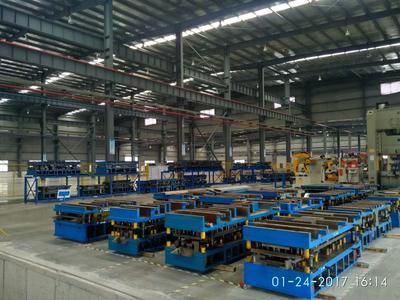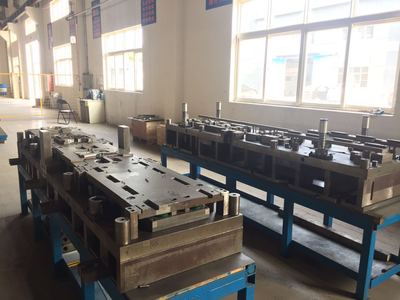Workstation progressive die is a high-precision, high-efficiency, and long-life mold developed on the basis of ordinary progressive die. It is an important representative of technology intensive molds and one of the development directions of stamping dies. This type of mold can not only perform punching and material cutting work, but also complete forming processes such as rib pressing, punching, bending, and deep drawing according to the characteristics and forming properties of the part structure. It can even complete assembly processes in the mold. When stamping, the strip or strip material is fed into the mold from the entrance end, and under strict control of step accuracy, it is continuously stamped at each station according to the order arranged by the forming process. After punching or cutting at the final station, the stamped parts that meet the product requirements can be produced. To ensure the normal operation of multi station progressive molds, the molds must have high-precision guidance and accurate distance control systems, equipped with automatic feeding, automatic dispensing, safety detection and other devices. So compared with ordinary stamping dies, multi station progressive dies are more complex and have the following characteristics:
(1) In a mold, multiple stamping processes including punching, bending, deep drawing, and forming can be completed; Reduced the turnover and repetitive positioning process of using multiple molds, significantly improving labor productivity and equipment utilization.
(2) Due to the fact that the process can be dispersed in different workstations in the progressive die, there is no "minimum wall thickness" problem for composite dies. During design, empty workstations can be left according to the strength of the die and the assembly needs of the die, thereby ensuring the strength and assembly space of the die.
(3) Multi station progressive dies usually have high-precision internal and external guidance (in addition to high precision requirements for mold frame guidance, internal guidance protection must also be implemented for small convex dies) and accurate distance systems to ensure the machining accuracy of product parts and the service life of the mold.
(4) Multi station progressive dies often use high-speed punching machines to produce stamping parts. The dies are equipped with automated devices such as automatic feeding, automatic output, and safety inspection, ensuring safe operation and high production efficiency. At present, the world's most advanced multi station progressive die has over 50 working positions and a stamping speed of over 1000 times per minute.
(5) The multi station progressive die structure is complex, with many inserts and high precision requirements for mold manufacturing, which brings certain difficulties to the manufacturing, debugging, and maintenance of molds. At the same time, it is required that the mold parts have interchangeability, and they should be replaced quickly, conveniently, and reliably after wear or damage. Therefore, the selection of materials for mold working parts must be good (often using high-strength high alloy tool steel, high-speed steel, or hard alloy materials), and advanced processing methods such as slow wire cutting, forming grinding, coordinate boring, and coordinate grinding must be applied to manufacture molds.
(6) Multi station progressive dies are mainly used for punching small and medium-sized parts with thin thickness (generally not exceeding 2mm), high output, complex shapes, and high precision requirements. The precision of parts made with this mold can reach IT10 level.
As can be seen from the above, the structure of multi station progressive dies is relatively complex, and the requirements for mold design and manufacturing technology are high. At the same time, there are corresponding requirements for stamping equipment and raw materials, and the cost of molds is high.
Our company has multiple years of experience in mold production, with an annual production capacity of over 400 sets. The photos of the production mold are as follows




